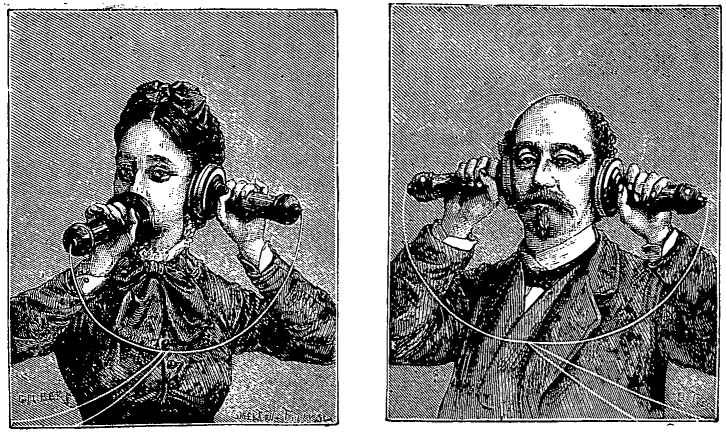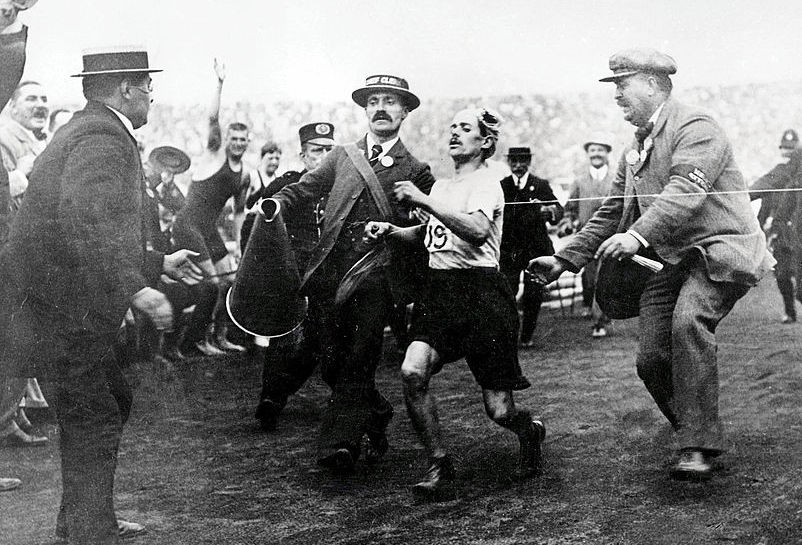
telepheme
n. a telephone message
telelogue
n. a conversation on the telephone

telepheme
n. a telephone message
telelogue
n. a conversation on the telephone

In 1908 a 22-year-old Italian baker’s assistant arrived in London to take part in the Olympic marathon. He had no coach, he spoke no English, and he was not expected to challenge the elite runners at the top of the field. In this week’s episode of the Futility Closet podcast we’ll follow Dorando Pietri on the most celebrated race in Olympic history.
We’ll also ponder the Great Mull Air Mystery and puzzle over a welcome murder.
This presentation, an in-joke among engineers, is technobabble but manages to seem oddly persuasive. In 1970, John Ware and Reed Williams of the University of Southern California School of Medicine ran an experiment that helps to show why.
The researchers arranged lectures on mathematical game theory for two audiences of psychiatrists and psychologists. In one classroom the lecturer was an actual scientist, and in the other he was an actor playing “Dr. Myron L. Fox” who’d been given one day to prepare a lecture “with an excessive use of double-talk, neologisms, non sequiturs, and contradicting statements.”
When both Fox and the scientist delivered their material in an inexpressive monotone, the scientist’s students performed better on an examination. But when both spoke engagingly, the students rated the charlatan as highly as the expert.
“The actor fooled not just one, but three separate audiences of professional and graduate students,” law professor Deborah J. Merritt wrote later. “Despite the emptiness of his lecture, fifty-five psychiatrists, psychologists, educators, graduate students, and other professionals produced evaluations of Dr. Fox that were overwhelmingly positive. … The disturbing feature of the Dr. Fox study, as the experimenters noted, is that Fox’s nonverbal behaviors so completely masked a meaningless, jargon-filled, and confused presentation.”
The lesson seems to be that an empty presentation delivered by a charismatic speaker can impress even an experienced audience.
(John E. Ware and Reed G. Williams, “The Dr. Fox Effect: A Study of Lecturer Effectiveness and Ratings of Instruction,” Journal of Medical Education 50:2 [1975], 149.)
Below: On Amazon’s Patriot, Leslie Claret schools John Lakeman in piping salesmanship.
When violinist Hugh Gordon Langton was killed in World War I, the Commonwealth War Graves Commission inscribed a phrase of music (below, click to enlarge) on his headstone in Belgium’s Poelcapelle British Cemetery.
What the notes represent has been a mystery for more than a century. “They are not part of a tune that anyone has been able to discern and several have tried,” writes Sarah Wearne in Epitaphs of the Great War: Passchendaele. “In particular they are not from the song ‘After the Ball’ as some have suggested.”
Langton is the only casualty who was commemorated with a piece of music — the CWGC maintains more than a million graves and memorials worldwide, and only this one bears musical notes as an epitaph. If you can identify the tune, please contact the Commission.
Mr. Beauclerk said [to Samuel Johnson:] Mr. ——–, who loved buttered muffins, but durst not eat them because they disagreed with his stomach, resolved to shoot himself; and then he eat three buttered muffins for breakfast, before shooting himself, knowing that he should not be troubled with indigestion; he had two charged pistols; one was found lying charged upon the table by him, after he had shot himself with the other.
— James Boswell, Life of Samuel Johnson, 1791

In 1833, to show that vultures found their prey by sight rather than smell, naturalist John Bachman made “a coarse painting representing a sheep skinned and cut open”:
This proved very amusing — no sooner was this picture placed on the ground than the Vultures observed it, alighted near, walked over it, and some of them commenced tugging at the painting. They seemed much disappointed and surprised, and after having satisfied their curiosity, flew away. This experiment was repeated more than fifty times, with the same result.
He confirmed the result by setting the painting within two feet of a heap of camouflaged offal in his garden. “They came as usual, walked around it, but in no instance evinced the slightest symptoms of their having scented the offal which was so near them.” He concluded that, while vultures may have a sense of smell, they don’t use it to find food.
See Vulture Picnic.
A poetic letter from Emily Dickinson to her aunt, Mrs. J. Howard Sweetser, late autumn 1884:
Dear Nellie,
I hardly dare tell you how beautiful your Home is, lest it dissuade you from the more mortal Homestead in which you now dwell — Each Tree a Scene from India, and Everglades of Rugs.
Is not ‘lead us not into Temptation’ an involuntary plea under circumstances so gorgeous? Your little note dropped in upon us as softly as the flake of Snow that followed it, as spacious and as stainless, a paragraph from Every Where — to which we never go — We miss you more this time, I think, than all the times before —
An enlarged ability for missing is perhaps a part of our better growth, as the strange Membranes of the Tree broaden out of sight.
I hope the Owl remembers me, and the Owl’s fair Keeper, indeed the remembrance of each of you, were a gallant boon — I still recall your Son’s singing, and when the ‘Choir invisible’ assemble in your Trees, shall reverently compare them — Thank you for all the Acts of Light which beautified a Summer now past to its reward.
Love for your Exile, when you write her, as for Love’s Aborigines — Our Coral Roof, though unbeheld, its foliage softly adds —
Emily, with Love
In 1956 Harvard psychologist George Miller pointed out a pattern he’d observed. If a person is trained to respond to a given pitch with a corresponding response, she’ll respond nearly perfectly when up to six pitches are involved, but beyond that her performance declines. Humans seem to have an “information channel capacity” of 2-3 bits of information: We can distinguish among 4-8 alternatives and respond appropriately, but beyond that number we start to founder.
A similar limit appears in studies of memory span. One psychologist read aloud lists of random items at a rate of one per second and then asked subjects to repeat what they’d heard. No matter what items had been read — words, letters, or numbers — people could store a maximum of about seven unrelated items at a time in their immediate memory.
It’s probably only a coincidence that these tasks have similar limits, but it’s still a useful rule of thumb: The number of objects an average person can hold in working memory is about seven.
(George A. Miller, “The Magical Number Seven, Plus or Minus Two: Some Limits on Our Capacity for Processing Information,” Psychological Review 63:2 [1956], 81-97.)
In 1878 R.W.S. Ralston, assistant librarian of the British Museum, wrote to Leo Tolstoy asking for some biographical information for an article he was writing. Tolstoy wrote back:
Dear Sir,
I am very sorry not to be able to give you a satisfactory answer to your letter. The reason of it is that I very much doubt my being an author of such importance as to interest by the incidents of my life not only the Russian, but also the European public. I am fully convinced by many examples of writers, of whom their contemporaries made very much and which were quite forgotten in their lifetime, that for contemporaries it is impossible to judge rightly on the merits of literary works, and therefore, notwithstanding my wishes, I cannot partake the temporary illusion of some friends of mine, which seem to be sure that my works must occupy some place in the Russian literature. Quite sincerely not knowing if my works shall be read after a hundred years, or will be forgotten in a hundred days, I do not wish to take a ridiculous part in the very probable mistakes of my friends.
Hoping that on consideration of my motives you will kindly excuse my refusal,
I am yours faithfully,
Count L. Tolstoy
Ralston got the information from Turgenev. His article appeared in 1879 under the title “Count Leo Tolstoy’s Novels.”
https://www.youtube.com/watch?v=dTd_M0gszvY
The clock on Bolivia’s congressional building runs counterclockwise.
Foreign Minister David Choquehuanca said the “clock of the south” had been adopted to affirm the country’s “southernness” and to encourage Bolivians to question norms and think creatively.
“Who says that the clock always has to turn one way?” he asked at a news conference in 2014. “Why do we always have to obey? Why can’t we be creative?”
Perhaps he’d been inspired by Venezuela, where in 2006 president Hugo Chávez raised a new national flag on which a white horse gallops left instead of right, “representing the return of Bolivar and his dream,” and the following year he put the nation’s clocks back half an hour “so that our bodies and above all our children take better advantage of sunlight and adapt the biological clock.”